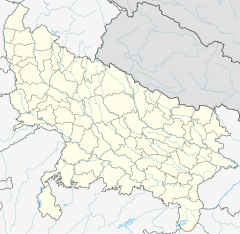|
Jhansi Junction railway station
Jhansi Junction railway station (officially Virangana Lakshmibai Jhansi Railway Station,[1] station code: VGLJ[2]) is a major railway junction in the city of Jhansi in Bundelkhand region of Uttar Pradesh.[3] It is one of the busiest and largest railway stations in India.[citation needed] It hosts various trains of Indian Railways like the Gatimaan Express, which is the fastest train of India, as well as others like Bundelkhand Express. It is a major halt for various important trains of Indian Railways like five sets of Rajdhani Express bound for Mumbai, Chennai, Bengaluru, Hyderabad etc. One set of Bhopal Shatabdi Express, three Duronto Express trains, Punjab Mail one of the oldest running trains in India, Kerala Express, Karnataka Express, etc. It is a major intercity hub and a technical as well as commercial stoppage for all trains passing through Jhansi. History The railway station was built by the British in the late 1880s. After a long survey of three places the current site was selected for the station. The station has a massive fort-like building painted in maroon and off-white. During ancient times, Jhansi was a stronghold of the Chandela Rajput kings and was known as Balwant Nagar. However, it lost importance in the 11th century after the decline of the Chandela dynasty. It rose in prominence in the 17th century when Raja Bir Singh Deo of Orchha State constructed the Jhansi Fort in 1613. The station had three platforms in the beginning. Platform One is 2,525 feet (770 m) long making it the fifth longest in the India. It could easily handle two trains at a time (Same are the cases with platforms two and three). The station was the focal point for The Indian Midland Railways Company which laid down lines radially in all directions from Jhansi, and managed the large workshop at Jhansi.[4] The first Shatabdi Express of India started between New Delhi and Jhansi. The fastest train of India Gatimaan Express runs between New Delhi and Jhansi. It is a high-priority train used by tourists and businessmen. Covering journey in 4 hours 10 minutes. Earlier Jhansi used to be a part of Central railways zone headquartered at Mumbai but now comes under North Central Railway Zone headquartered at Allahabad. On 1 January 2022, the train station was renamed from Jhansi Junction to Virangana Lakshmibai Railway Station in memory of Rani Lakshmibai, the former Queen, or Rani, of Jhansi who fought against the British.[1] This change also changed the station code from JHS to VGLB, and the numerical code to 13309727.[1][5] There is a social media campaign against the new name, and people have complained about the name to the MP for Jhansi, Anurag Sharma saying that "Jhansi" should be part of the station's name.[1] Connectivity Virangana Lakshmibai Jhansi Junction (Jhansi Junction) Railway Station is linked with many industrial and important cities of India by direct trains like New Delhi, Prayagraj, Mumbai, Bangalore, Kolkata, Sagar, Lucknow, Etawah, Varanasi, Jabalpur, Pune, Hyderabad, Bhubaneswar, Kanpur, Vasco da gama, Vijayawada, Visakhapatnam, Udaipur, Amritsar, Pathankot, Lucknow, Bhopal, Chennai, Gorakhpur, Coimbatore, Jammu, Agra, Amaravati, Raipur, Ahmedabad, Banda, Nagpur, Thiruvananthapuram, Kochi, Kozhikode etc. Virangna Lakshmibai Jhansi Junction Railway Station is served by 4 broad gauge routes:
There is an ongoing survey for a new line between Virangana Lakshmibai Jhansi Junction Railway Station and Shivpuri in Madhya Pradesh which would be further connected to Sawai Madhopur and Jaipur. Many Indian Railways trains pass through Jhansi, including the Gatimaan Express (currently the fastest train in India).
Jhansi is an important destination for tourists intending to go to Khajuraho, a UNESCO World Heritage Site and Orchha. Facilities
Trains boarding from Jhansi Junction Railway Station
and several other passengers and shuttles trains connecting Lucknow, Kanpur, Agra Cantt, Prayagraj, Manikpur, Banda Jn, Khajuraho, Tikamgarh, Bhopal, Bina and Itarsi. Loco shedsJhansi has both the Electric & Diesel loco sheds. Its has many electric and diesel locos together.
See alsoReferences
|
||||||||||||||||||||||||||||||||||||||||||||||||||||||||||||||||
Portal di Ensiklopedia Dunia



